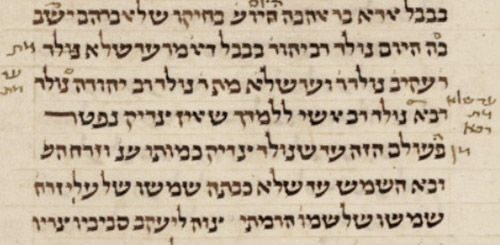

In the Marvelous Middos Machine 3, “Does Anyone Have the Time,” Dr. Middos is able to contact Shnooky Shapiro — who had accidentally gone back in time — via his bein hazmanim radio. I wonder if Rav Ashi, the fifth-generation Babylonian Amora, had access to such a device.
When I perform a Sefaria search on the phrase: “Rava said to Rav Ashi,” I get a number of hits, but these are typically “Rav Acha, son of Rava,” “said to Rav Ashi,” or “Rav Chanan bar Rava said to Rav Ashi.” This makes sense, because Rava’s student was Rav Pappa and Rav Pappa’s student was Rav Ashi. We shouldn’t expect conversation skipping over a scholastic generation.
However, in our sugya — Ketubot 111a — he appears to do so. Rabbi Eleazar (presumably ben Pedat, the second-generation Amora) interprets a verse (Yeshaya 33:24) to mean that anyone who dwells in Israel, dwells without transgression. The verse reads: “And the inhabitant (of Israel) shall not say I am sick; the people who dwell there will be forgiven their iniquity.” Much later, Rava tells Rav Ashi, “We interpret that verse as referring to those who suffer from ailments.”
This raises red flags, because we assume that Rava and Rav Ashi’s lifetimes didn’t overlap. This is based on Kiddushin 72b, which discusses the overlapping lifespans of skipped scholastic generations of Chazal. Thus, “כְּשֶׁמֵּת רַבִּי עֲקִיבָא נוֹלַד רַבִּי,” when Rabbi Akiva (a fourth-generation Tanna) died, Rabbi (Yehuda Hanasi, a sixth-generation Tanna) was born. When Rabbi died, Rav Yehuda was born. Note: that Rabbi was a last generation Tanna, Rav, a first-generation Amora, and his student, Rav Yehuda, a second-generation Amora. When Rav Yehuda died, Rava (fourth-generation) was born. When Rava died, Rav Ashi (sixth-generation) was born. Thus (and from here is a transfer from Yoma 38b, where Rabbi Yochanan says), Kohelet 1:5 states, “the sun also rises and the sun also sets.” Similarly, before Eli the Kohen’s sun set, the Navi Shmuel’s sun was rising.
This is understood to mean that Rav Ashi was born on the same day Rava died — and so for each pair — and this is used to establish known lifespans. So Rava lived from 280-352 CE, while Rav Ashi lived from 352-427 CE. How could Rava have said anything to Rav Ashi?
We could reinterpret “נוֹלַד” in that Gemara to mean that he had already been born, like a pluperfect. The real reason to think otherwise is that, regarding Rabbi Yehuda HaNasi and Rav Yehuda — the previous segment stated that the same day Rabbi rested in Avraham’s lap, Rav Yehuda was born, and then justifies the idea with a citation, via “אמר מר,” of the skipping generations. Perhaps, the Talmudic narrator understood the sugya in this way; even if we might not. I’d add that Shmuel interacted with Eli as a youth, though that portion of the sugya is transferred from Yoma. Finally, the Oxford 367 and Vatican 110 manuscripts have “עד שלא מת” instead of “כשמת,” which more clearly allows for overlap and interaction. Still, the fact that Rava and Rav Ashi don’t commonly interact, makes me suspicious of their interaction in our sugya of Ketubot 111a.
Looking into manuscripts of Ketubot 111a, we find that the scribe of Munich 95 was uncomfortable with the interaction and simply wrote “א”ל לרב אשי,” omitting Rava. Firkowitz 187 has Rabbi Abba speaking to Rabbi Yossi. (The apostrophes indicate the title isn’t spelled out.) Similarly, Fr. ebr. 608 has Rabbi Abba speaking to Rav Ashi. And even though the CUL: T-S F 2(2).20 fragment regularly spells Rava as “רבא” on the page; whereas here, it spells it as “ראבה,” with nekudot, perhaps originating in Rabbi Abba.
As Rav Aharon Hyman notes in “Toldot Tannaim vaAmoraim” that there are several Amoraim named “Rabbi Abba.” Rabbi Abba III is a sixth-generation contemporary of Rav Ashi, who came from Israel — but, as Hyman notes, everyone who deals in Amoraic biography forgot about him! Thus, every time they encounter Rabbi Abba with Rav Ashi, they either invent the existence of an earlier Rav Ashi or suggest a gloss to change Rav Ashi to (the first-generation) Rav Assi. He was a Jerusalemite who, when the yeshivot in Israel were destroyed around 360 (363?) CE, when the last non-Christian Caesar Julianus was assassinated and the Christians came to power, Rabbi Abba fled to Bavel. This overlaps with Rav Ashi’s leadership, so Rabbi Abba could play a role in the redaction of the Talmud. Hyman notes that there were other scholars before him who said this, as well as a Teshuvat HaGeonim which states “in the days of Rabbi Abba and Rabbi Chanina, the later ones, who were in the days of Rav Ashi.”
Rav Hyman then notes Rabbi Abba interacted with Rav Ashi many times and related the Torah of Eretz Yisrael. For instance, in Shabbat 150b, he says, “in the West (meaning Israel) we say, ‘Hamavdil bein kodesh l’chol,’ and (immediately) attend to our needs.” So too, “in the West,” as it says in Bava Kamma 27b. In many other places, he says: “אתון מהכא מתניתו לה אנן מהכא מתנינן לה — you (plural) learn it from here, but we learn it from there.”
This fits perfectly with Ketubot 111a (which is one of the many places Hyman lists), for his language is: “אֲנַן בְּסוֹבְלֵי חֳלָאִים מַתְנֵינַן לַהּ — we … teach it in this manner.”
Given that the subject is how to understand a verse about what forgives one from sin, it is quite meaningful that an Amora from Israel explains the Israeli Amoraic understanding as not simply “living in Israel.” More so, than Rav Ashi’s own grand-teacher explaining how they — in contrast to who — teach it.
By Rabbi Dr. Joshua Waxman










